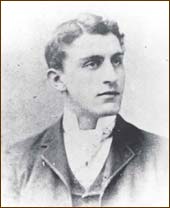- F. Augustus Heinze
__NOTOC__Infobox Person
name=F. Augustus Heinze
caption=F.Augustus Heinze
birth_date=1869
birth_place=Brooklyn ,New York , U.S.
death_date=death date|1914|11|4 [ [http://pqasb.pqarchiver.com/boston/access/713984602.html?dids=713984602:713984602&FMT=ABS&FMTS=ABS:AI&date=Nov+05%2C+1914&author=&pub=Boston+Daily+Globe&desc=F.+AUGUSTUS+HEINZE+DIES+AT+SARATOGA "Boston Daily Globe:" F. Augustus Heinze dies at Saratoga] ]
death_place=Saratoga, New York Fritz Augustus Heinze (German: IPA2|ˈhaɪntsə) (1869 –
November 4 ,1914 ) was one of the three "Copper Kings " ofButte, Montana along withWilliam Andrews Clark andMarcus Daly . Heinze was one of the most colorful entrepreneurs in Montana history.Early life
F. Augustus Heinze was born in
Brooklyn ,New York ,United States , to German immigrants. He graduated from Brooklyn Polytechnic Institute (now Polytechnic University) and later attendedColumbia University . [cite news
author=
title=F. AUGUSTUS HEINZE, MINE OWNER, DEAD; Stricken Suddenly at His Home in Saratoga, Where He Had Gone to Vote. HIS MONTANA OPERATIONS Won $10,000,000 Verdict from Amalgamated Copper Co. ;- Prosecuted as Head of Mercantile Bank.
date=
work=New York Times
url=http://query.nytimes.com/gst/abstract.html?res=990DE4D6113FE633A25756C0A9679D946596D6CF
accessdate=2008-08-08] He went to Butte in 1889 as a mining engineer for the Boston and Montana Company.Business career
Although Heinze arrived in Butte after Clark and Daly were well established, he was able to catch up with the other two moguls through the use of mining law and court lawsuits.
In 1893, Heinze organized the Montana Ore Purchasing Company and began a series of court challenges to the claims of the established interests in Butte, most notably the
Amalgamated Copper Mining Company (renamedAnaconda Copper in 1915). Amalgamated was controlled by directors of theStandard Oil Company.Heinze bought judges to support his cause. He was known to have over thirty judges on his staff at one point in time. He was also notorious for his methods of bending the mining law to gain wealth. He bought a small triangular plot of land amongst other much larger claims by three other mining kings, which would normally be expected to be of little use. But the mining law directed that an owner could mine the veins that outcropped on his claim, and follow them underground beneath claims owned by others. This is known as the "law of the apex", and led to many legal and physical battles in western mining districts. Heinze maintained that many veins outcropped on his tiny parcel, and that his miners therefore had the right to take out copper ore from beneath his neighbors. His miners dig straight down into the small plot, and then spread out in all directions underneath the surrounding claims. When the other mining moguls complained, Heinze's bought judges would throw out their cases, ruling that Heinze's parcel contained the apex of the copper veins, and so the copper belonged to him.
In 1902, Heinze combined his various interests into
United Copper , an $80,000,000 firm with capacity to produce 42,000,000 pounds of copper a year, compared to 143,000,000 a year produced by Amalgamated.In 1906, Heinze sold his mining interests in Butte to the Amalgamated Copper Mining Company for a sum of $10.5 million. He returned to New York and entered the banking business, forming a close alliance with
Charles W. Morse with whom he served on at least six national banks, 10 state banks, 5 trust companies and four insurance companies. Soon, he would lose his fortune and set off thePanic of 1907 .The events of October 1907 brought a total of 16 counts of financial malfeasance. However, a series of fortunate incidents in the courts led to his complete exoneration in 1909, and on Nov. 7 of that year he returned to Butte, Montana. Despite full exoneration by the courts, the events of October 1907 left an indelible mark on his life: his mining ventures collapsed, his relationships with his brothers (former business partners) were destroyed, his marriage failed and his health disintegrated. He became "distraught in appearance"; at 37, his hair was almost completely white. In 1914, just 44 years old, Heinze suffered a hemorrhage of the stomach caused by cirrhosis of the liver, and died. [ [http://minneapolisfed.org/pubs/region/89-08/REG898C.cfm Federal Reserve Bank of Minneapolis] – F. Augustus Heizne and the panic of 1907]
References
Further reading
*cite book |title=Copper King at War |last=McNelis |first=Sarah |authorlink= |coauthors= |year=1968 |publisher=University of Montana Press |location=Missoula |isbn= |pages=
External links
* [http://minneapolisfed.org/pubs/region/89-08/REG898C.cfm Federal Reserve Bank of Minneapolis] – F. Augustus Heinze and the panic of 1907
Wikimedia Foundation. 2010.
